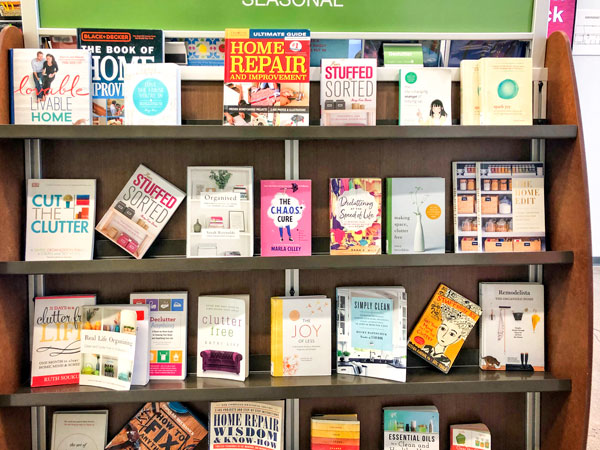Re-thinking spring cleaning
Article and photo by Lisa Nicklanovich


The Douglas County Libraries – Castle Pines seasonal section was packed with books about decluttering and simplifying, reflecting the growing momentum of living with less.
Spring is in the air, and while many are staying close to home and looking for projects to do, we can throw open the windows, clear the dust, spruce and reduce. Spring cleaning often leads to decluttering, and Japanese organizing consultant and author Marie Kondo’s KonMari Method has exploded in popularity.
Kondo made “tidying” a process in which you examine each item you own and ask if it sparks joy. The fact that her four books have sold millions of copies around the world and that there was a surge in donations across the country after her Netflix show aired, clearly indicates that there is a deep desire out there for decluttering. According to a study published in the Journal of Environmental Psychology, a clean space is key to maintaining positive relationships, reducing stress, and promoting overall well-being.
We keep items for so many reasons. Maybe because of how much we paid for it. Maybe it’s a scarcity mindset, or simply an attachment to a particular item. The KonMari Method empowers people to let go of items with gratitude, and only keep those things which support a vision of an ideal lifestyle. Those joy-giving belongings which remain should be visible, accessible and enjoyed, Kondo says.
The KonMari Method is not to be confused with minimalism. Minimalists, in contrast, attempt to pare down their possessions to what is essential. Industry experts Joshua Fields Millburn and Ryan Nicodemus define minimalism as “a tool that can assist you in finding freedom.” The idea goes that when you clear away all the stuff, you make room for the things that matter.
This leads to questions about where all our discards go and how and why new purchases are made. Buyers are interested in the environmental impact and the sustainability of what they purchase, which explains the surge in “intentional consumption.” There is a craving out there for the freedom that comes with living with less and purchasing according to one’s values.
If it is true that the average American home contains more than 300,000 items and that we tend to only use the same small percentage of our belongings, it is worth some mindful consideration to look around and make choices about what we enjoy and what we simply don’t need.
While we all won’t choose to become minimalists or ask if our possessions spark joy, there are growing movements in that direction. Imagine wearing only 33 items for three months, like minimalist advocate Courtney Carver who created Project 333, a movement she says that allows you to “be more with less.” Imagine living in a house that is only 400-square-feet or less like Ryan Mitchell, who is the founder of TheTinyLife.com, a website dedicated to sharing stories of tiny living. Mitchell says tiny living has given him the freedom to pursue his passions. Imagine if your yearly trash output could be small enough to fit inside an eight-ounce mason jar. Blogger Kathryn Kellog, who is part of a growing zero-waste movement, strives for this.
While these ideas may sound extreme, thousands of people claim it makes life easier, not harder.
For more information, visit https://konmari.com/, www.becomingminimalist.com, www.bemorewithless.com, www.goingzerowaste.com or visit your local library.